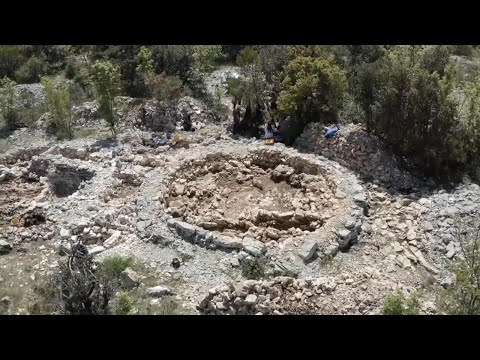(28 Apr 2024)
CROATIA ARCHAEOLOGY
SOURCE: ASSOCIATED PRESS
RESTRICTION SUMMARY:
LENGTH: 8:21
ASSOCIATED PRESS
Zakotorac, Croatia – 19 April 2024
1. Aerial shot of rugged terrain
2. Tracking shot following archaeologist to dig site
3. Aerial shot of circular burial mound being excavated
4. Various of archeologists documenting site, excavating by hand
5. Close of archaeologist digging up round object
6. SOUNDBITE (Croatian) Hrvoje Potrebica, archaeologist, University of Zagreb:
"The helmets were found in the context of a cemetery at a burial site, but they were not there as burial artefacts. They were not put there alongside the deceased and they didn’t belong to any person buried there. They were both found as separate objects, laid in a way which indicates that this was some kind of a cult practice. These were votive gifts left to pay respect to deities or people buried here. We don’t think that they are related to any specific person buried here because the site contains remains of dozens of individuals."
7. Various of Potrebica excavating site
8. SOUNDBITE (Croatian) Hrvoje Potrebica, archaeologist, University of Zagreb:
"In the 5th century BC, we see a sudden appearance of extremely powerful elites here, people who demonstrate their prestige by wearing this type of very exclusive warrior equipment, which is hard to come by, like Greco-Illyrian helmets. So, these objects point to economic and cultural connections between the Mediterranean and the rest of Europe. The fact that we have two helmets here, used as part of a cult ritual, tells us that this was a very significant location at the time."
9. Greek-Illyrian helmet dating from 5th century BC, rotating on table
10. SOUNDBITE (Croatian) Hrvoje Potrebica, archaeologist, University of Zagreb:
"What we can gather from this site is that there were communities here which existed for thousands of years, which reached their peak in the 5th century BC. They developed so much that they were buying expensive Greek goods, the same way we buy expensive cars or other prestigious objects. So, this signals to Greek colonies in southern Italy to start seeing these communities as good spenders and consumers of their products."
11. Various of pieces of jewelry found at Zakotorac
12. SOUNDBITE (Croatian) Hrvoje Potrebica, archaeologist, University of Zagreb:
"These helmets, along with these signs of immense wealth, turn the narrative of Greek colonization of the Mediterranean upside down, we can view that story now from a different perspective. In the past, we had no access to this data, we only had to rely on ancient sources and our knowledge of the Greeks, so we viewed these communities via the colonial lens, through the eyes of those who arrived here. But now, we can see them through the eyes of natives, who, in a way, spurred their arrival."
ASSOCIATED PRESS
Viganj, Croatia – 19 April 2024
13. Various of Korcula island seen from mainland
14. Wide of Orebic town on Peljesac peninsula
ASSOCIATED PRESS
Nakovana, Croatia – 20 April 2024
15. Aerial shot of burial cairns at Nakovana site
16. Remains of burial cairn
17. Various of sign showing burial cairns in area
18. Tracking shot following local historian Ivan Pamic into exhibition
19. Various of exhibition about Illyrian and Roman periods
20. SOUNDBITE (Croatian) Ivan Pamic, local historian and exhibit curator:
ASSOCIATED PRESS
Dubrovnik, Croatia – 22 April 2024
21. Wide of Dubrovnik old town
22. Various of busy street and square
23. Archeologist Domagoj Perkic laying down small objects found in burial cairns on table
STORYLINE:
LEADIN:
Find out more about AP Archive: http://www.aparchive.com/HowWeWork
Twitter: https://twitter.com/AP_Archive
Facebook: https://www.facebook.com/APArchives
Instagram: https://www.instagram.com/APNews/
You can license this story through AP Archive: http://www.aparchive.com/metadata/youtube/e12163dec24e427c851dc928b81d15c1





